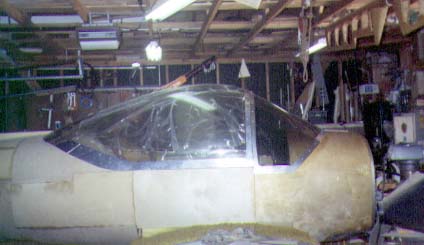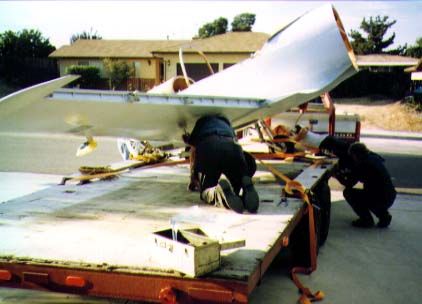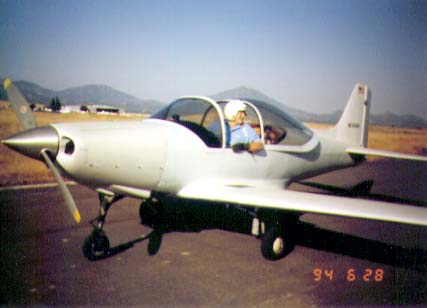Saga of the
Unsinkable Miss Fitt
![]()
Saga of the
|
|
by Allan Hall
This article appeared in the September 1994 Falco Builders Letter. |
Once upon a time... I wanted to build an airplane. The airplane is now built, and has flown. I'll try to spare you all of the sordid details, and try to hit the salient points of getting from there to here.
Decision No. 1: Which airplane? After looking at a few, and talking to John Shipler on the phone, it had to be a Falco. I've never met John, who lives a few miles north of here, but his project was near completion. He is an experienced builder, and I valued his advice. He didn't try to sell me, but he did!
Decision No. 2: This wasn't much of a problem-whether to buy or build components. It was apparent that I could buy things better and cheaper than I could hack them out myself.
I probably hold the record for "slowest builder". The plans arrived in the summer of '84. A certificate of airworthiness was issued in March 1993. When anyone asks how long it took me to build the airplane, I try to change the subject. However, my excuses for this snail's pace are (1) that I'm old (80 in November '94), and (2) that there were distractions such as terminal cancer in my immediate family-when the airplane went on the back burner.

Building the thing was probably the most satisfying experience of my life. The detailed drawings, and Alfred's instructions made everything fall into place like magic. The entire airplane was constructed, strictly 'by the book' in my three-car garage. You may still observe the outline by the glue drippings on the garage floor!
Speaking of glues, I used them all, Aerolite, Penacolite and T-88. T-88 was my choice for most major joints since it seemed the strongest (and the most forgiving). Of course, I had to paint Miss Fitt white, because of the epoxy (T-88) glue.
When everything was assembled (except the engine), it was time to move to a hangar. The closest hangar for rent was in Ramona, California, about an hour's drive from here (Vista, CA). A mover was willing to move the plane, providing I would take care of the wide load permits needed to go through every town and highway to be traversed. This turned out to be a formidable job, so I found a mover who "didn't know" that wide load permits were required. He moved the thing over there in about an hour without a scratch or other incident.

Moving day for the Falco. "You probably recognize me in the foreground"--Allan
Hall
After final assembly, I took Alfred's advice and hired a mechanic at $42/hour to inspect my masterpiece. It turned out to be a good investment. He could find more wrong in an hour than I could correct in a day. One stupid example: he found terminal nuts on the ground bus that were barely finger tight.
Now for the big inspection, I called the FAA inspector in San Diego, and arranged a date. During our phone conversation, he stressed the importance of the emergency locator transmitter installation. I called Aircraft Spruce, and they rushed one each ELT down to me. The FAA inspector arrived bright and early one morning, OK'd the airplane for an airworthiness certificate, and went on his way. He never mentioned the ELT, which is still in its carton in a back corner of the hangar.

Cousin Bob after Miss Fitt's first flight. Notice the crash helmet and the
heat
barrier gloves--remnants of his days at the Air Force Test Pilot School.
For a test pilot, I chose my cousin, Bob, mostly because he wanted to do it! He's a retired Air Force colonel, has flown everything in the Air Force and has just short of 38,000 hours in the air. Finally he managed to get up here in June '94 (he resides in San Antonio). Bob read the Falco Flight Test Guide, and proclaimed it very good. Then after two mornings of taxi tests, he was ready to fly.
The third morning we strapped him in, and he and Miss Fitt took off as routinely as though they had been doing it for years. Bob wore his crash helmet, which was incompatible with the radio, so I did the radio work for him from the ground with a walkie-talkie. At the same time, I was trying to operate a camcorder, and consequently didn't do a very good job at anything.
After a beautiful approach and landing, his first words were, "Anybody can fly this airplane!" I wanted to know which wing was heavy, and I had a piece of aluminum cut for an aileron tab-because I was sure that one wing would be heavy. However, he said it flew perfectly.
He also said I was right-Miss Fitt is a little nose-heavy. The only trouble that he mentioned was "A little trouble with the flair". I suspect that was due to his belly interfering with the stick. He is short and pudgy, and he had to have the seat all the way forward plus an extra cushion for his back. Bob had to leave right away for an appointment in Bakersfield-so I didn't get a chance to ride in Miss Fitt so far, darn it!
Now that I have an airplane that will fly, where do we go from here? My medical had run out, so last week I took the physical and-surprisingly enough-passed! Now if I'm lucky, I'll find someone who can check me out in Miss Fitt, then get a CFI to give me a BFR, and I'll be ready to enjoy.
In conclusion, I wish to thank Alfred and the rest of them at Sequoia Aircraft for their patience and understanding with this old man through the several years of this project. And it did keep me off the streets for a while!